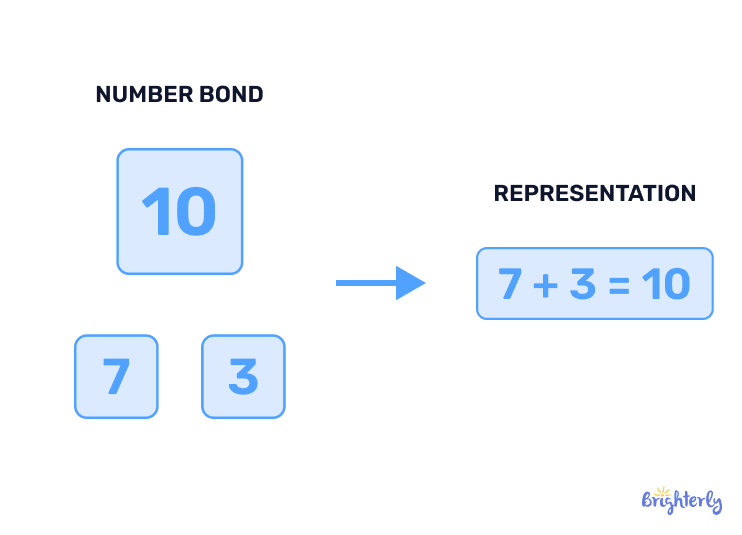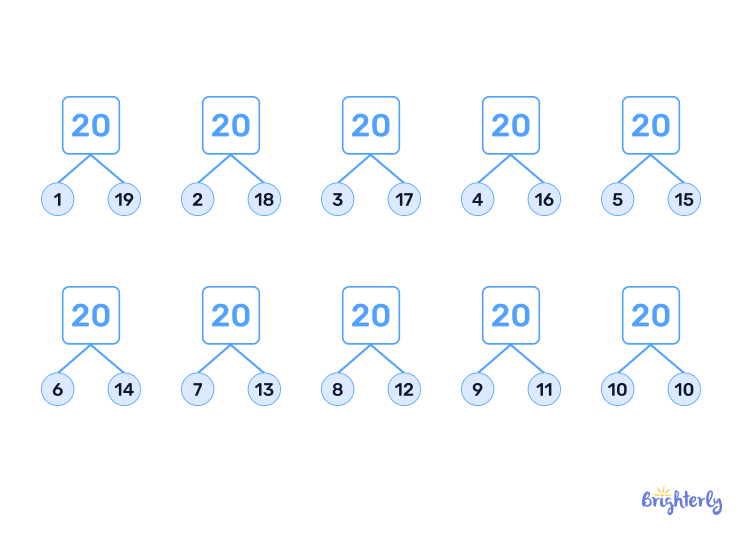Number Bonds – Definition with Examples
Updated on November 27, 2025
Welcome to Brighterly, where we make the journey of learning math fun and exciting!
Foundational skills are super important for successful math. Once children have laid the foundation of simple concepts, they can understand more complex ones.
One of those concepts is number bonds. These are pairs of numbers that add up to another number. The topic is key to helping children learn addition and subtraction while also supporting mental math, as they can easily recall certain facts and use them to tackle more challenging sums.
Here, we’re going to cover the definition of number bonds, the number bonds of certain numbers, and how they relate to the four operations of addition, subtraction, multiplication, and division. Then we’ll give you some solved math questions on number bonds so you can understand how to answer these questions, before you try your hand at your own practice!
Number bond: Introduction
Number bonds are one of the most fundamental concepts in math that kids will learn at an early age. These bonds help children understand the concepts of addition and subtraction and improve recall and mental math skills.
Kids will also improve their number sense and problem-solving skills, which will become key throughout their math education. They lay the foundation for future learning as one of the most important building blocks in mathematics. Here, we’ll take you through how to do number bonds.
What are number bonds?
Number bonds are pairs of numbers that add up to make another number. By pairing numbers together, we make recall easier for children. They can also derive other facts from these numbers, like subtraction.
Let’s take the number bond example of 5 and 4. As a number bond, they add up to 9. Children can also use this to work out that 9 – 4 = 5. Each number also has its own set of number bonds, so for 9, these are:
- 0 + 9 = 9
- 1 + 8 = 9
- 2 + 7 = 9
- 3 + 6 = 9
- 4 + 5 = 9
This illustrates the whole-part relationship of numbers, which states that numbers can be broken down into smaller components. This is often visualized through a part-whole model.

Number bonds of 5
All numbers have number bonds that, when added together, equal our number. Let’s look at the number 5 first. Its bond numbers are:
- 0 + 5 = 5
- 1 + 4 = 5
- 3 + 2 = 5
Number bonds of 10
Now, let’s take a look at the number bonds of 10. Often, children first learn number bonds up to 10, as counting to 10 is also a key part of early education. The number bonds to 10 are:
- 0 + 10 = 10
- 1 + 9 = 10
- 2 + 8 = 10
- 3 + 7 = 10
- 4 + 6 = 10
- 5 + 5 = 10
Number bonds of 20
Now, let’s look at a larger number like 20. Learning the number bonds of bigger numbers helps children solve increasingly more complex sums. The number bonds to 20 are:
- 0 + 20 = 20
- 1 + 19 = 20
- 2 + 18 = 20
- 3 + 17 = 20
- 4 + 16 = 20
- 5 + 15 = 20
- 6 + 14 = 20
- 7 + 13 = 20
- 8 + 12 = 20
- 9 + 11 = 20
- 10 + 10 = 20

Number bonds addition
Number bonds are among the most important tools for children learning addition. This topic helps children visualize addition.
It also helps children understand the concept of carrying numbers in addition. These number bonds make solving less ‘round’ equations easier. For example, if a child has the sum 6 + 7 and knows 6 + 4 = 10, they can carry the 4 from the 7 and then add the remaining 3. This is often much faster to do mentally.
Number bonds subtraction
Number bonds are also incredibly important when it comes to subtraction. When kids know that certain numbers combine to create another number, they can reverse in a subtraction equation. This again helps them to visualize the operation.
Let’s look at some number bond examples. If a child knows that 2 + 8 = 10, they can easily reverse it and know that 10 – 8 = 2 without performing any additional calculations. It also strengthens their understanding of methods like borrowing, which is similar to carrying in addition. If a child has the sum 13 – 5 = 8, they can break 13 down to 10 and 3, then subtract 3 before subtracting the remaining 2. Number bonds addition and subtraction are the key uses of this topic.
Number bonds multiplication
While we use number bonds to teach addition and subtraction, they can also be used in multiplication and division. In fact, we could consider the times tables a version of multiplication number bonds! For example, let’s look at the number bonds of 50 in multiplication:
- 1 x 50 = 50
- 2 x 25 = 50
- 5 x 10 = 50
If you’ve been introduced to factors and factor pairs before, you’ll see that these number bonds also operate as factor pairs!
Number bonds division
As with addition and subtraction, if children know the number bonds of multiplication, they can easily reverse them to make division easier. Division is considered the most challenging of the four operations, so having a trick like division number bond up your sleeve can make it feel much less daunting.
Let’s use a number bonds example from above. We know that 2 x 25 = 50, so we can easily reverse this and say that 50 ÷ 25 = 2. Initially, that sum may look complex, but it’s easy once you know your number bonds and factor pairs!
Benefits of number bonds
There are so many benefits to learning number bond math for children:
- Number bonds strengthen number sense, which is a fundamental skill that allows children to understand the relationship between numbers
- They help children with mental math, helping to easily recall facts like 5 + 5 = 10
- They can be reversed, helping children solve subtraction and division problems
Solved examples on number bonds
Now, let’s take a look at some solved questions. By answering them, we’re helping you understand how you will solve related questions independently!
Solved math task 1
Using the bond number 5 + 3 = 8, solve the following sum: 8 – 3.
Answer
| 5 |
By reversing our number bond, we can easily solve this. If 5 + 3 = 8, then 8 – 3 = 5.
Solved math task 2
Using number bonds, find the missing number: 9 + ? = 10
Answer
| 1. |
Learning number bonds, we know that 9 + 1 = 10.
Solved math task 3
Using the number bond 3 x 2 = 6 to solve the following division problem: 6 ÷ 2.
Answer
| 3. |
By reversing 3 x 2 = 6, we get 6 ÷ 2 = 3.
Practice problems on number bonds
Now, it’s your turn! Use the solved examples above to apply your knowledge to these questions.
- What is the missing number? 6 + ? = 10
- Use number bonds to solve the subtraction problem: 10 – 4 = ?
- Use number bonds to solve the division problem: 24 ÷ 6 = ?
Conclusion
Now you know everything there is to know about number bonds! This will be key on your journey through math, helping you understand the relationship between numbers, add and subtract more quickly, and even tackle more complex multiplication and division problems! This topic lays the groundwork for more advanced math learning and can help children understand factor pairs and more.
Frequently asked questions on number bonds
What is a number bond?
A number bond is a pair of numbers that can be added together to make another number. These numbers help children to add more quickly and can be used in reverse to solve subtraction sums too. They can also be applied to multiplication and division.
How do number bonds work?
Number bonds demonstrate how two parts, aka numbers, come together to make a whole, aka another number. They work to make addition and subtraction easier for kids, as they can recall these facts to solve problems.
How to teach number bonds?
To teach number bonds to kids, you can either clarify the bonds of certain numbers or use Brighterly’s number bonds worksheets, which contain diverse problems on the topic.
What are number bonds to 10?
The number bonds to 10 are:
- 0 + 10
- 1 + 9
- 2 + 8
- 3 + 7
- 4 + 6
- 5 + 5
How do number bonds help in learning math?
Number bonding helps kids learn math by allowing them to understand the relationships between numbers. They also strengthen mental math skills, because kids can easily recall bonds. This also helps with math operations like addition, subtraction, multiplication, and division.






